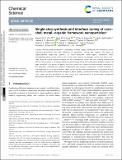Files in this item
Single-step synthesis and interface tuning of core–shell metal–organic framework nanoparticles
Item metadata
| dc.contributor.author | Orr, Kieran W. P. | |
| dc.contributor.author | Collins, Sean M. | |
| dc.contributor.author | Reynolds, Emily M. | |
| dc.contributor.author | Nightingale, Frank | |
| dc.contributor.author | Boström, Hanna L. B. | |
| dc.contributor.author | Cassidy, Simon J. | |
| dc.contributor.author | Dawson, Daniel McLean | |
| dc.contributor.author | Ashbrook, Sharon E. | |
| dc.contributor.author | Magdysyuk, Oxana V. | |
| dc.contributor.author | Midgley, Paul | |
| dc.contributor.author | Goodwin, Andrew L. | |
| dc.contributor.author | Yeung, Hamish H.-M. | |
| dc.date.accessioned | 2021-02-17T20:56:43Z | |
| dc.date.available | 2021-02-17T20:56:43Z | |
| dc.date.issued | 2021-02-09 | |
| dc.identifier | 272862166 | |
| dc.identifier | 11aa6dda-2a1e-46fd-b19b-d6af5bbd4e4b | |
| dc.identifier | 85103502180 | |
| dc.identifier | 000635768300028 | |
| dc.identifier.citation | Orr , K W P , Collins , S M , Reynolds , E M , Nightingale , F , Boström , H L B , Cassidy , S J , Dawson , D M , Ashbrook , S E , Magdysyuk , O V , Midgley , P , Goodwin , A L & Yeung , H H-M 2021 , ' Single-step synthesis and interface tuning of core–shell metal–organic framework nanoparticles ' , Chemical Science , vol. Advance Article . https://doi.org/10.1039/D0SC03940C | en |
| dc.identifier.issn | 2041-6520 | |
| dc.identifier.other | ORCID: /0000-0002-4538-6782/work/88730950 | |
| dc.identifier.other | ORCID: /0000-0002-8110-4535/work/88730976 | |
| dc.identifier.uri | https://hdl.handle.net/10023/21443 | |
| dc.description | HHMY thanks the Samuel and Violette Glasstone Bequest for a fellowship, the John Fell Fund (OUP) for funding, and the University of Birmingham for startup funds. This project has received funding from the European Union Horizon 2020 research and innovation program under the Marie-Sklodowska-Curie grant agreement 641887 (DEFNET). SMC acknowledges support from the Henslow Research Fellowship at Girton College, Cambridge. PAM thanks the EPSRC for financial support under grant number EP/R025517/1. ALG thanks ERC for funding (Grant. 788144). The research leading to this result has been supported by Diamond Light Source (Beamtimes EE20946 (I12), and EE18786 (I11 Block Allocation Grant). | en |
| dc.description.abstract | Control over the spatial distribution of components in metal–organic frameworks has potential to unlock improved performance and new behaviour in separations, sensing and catalysis. We report an unprecedented single-step synthesis of multi-component metal–organic framework (MOF) nanoparticles based on the canonical ZIF-8 (Zn) system and its Cd analogue, which form with a core–shell structure whose internal interface can be systematically tuned. We use scanning transmission electron microscopy, X-ray energy dispersive spectroscopy and a new composition gradient model to fit high-resolution X-ray diffraction data to show how core–shell composition and interface characteristics are intricately controlled by synthesis temperature and reaction composition. Particle formation is investigated by in situ X-ray diffraction, which reveals that the spatial distribution of components evolves with time and is determined by the interplay of phase stability, crystallisation kinetics and diffusion. This work opens up new possibilities for the control and characterisation of functionality, component distribution and interfaces in MOF-based materials. | |
| dc.format.extent | 9 | |
| dc.format.extent | 1435884 | |
| dc.language.iso | eng | |
| dc.relation.ispartof | Chemical Science | en |
| dc.subject | QD Chemistry | en |
| dc.subject | DAS | en |
| dc.subject.lcc | QD | en |
| dc.title | Single-step synthesis and interface tuning of core–shell metal–organic framework nanoparticles | en |
| dc.type | Journal article | en |
| dc.contributor.institution | University of St Andrews. School of Chemistry | en |
| dc.contributor.institution | University of St Andrews. EaSTCHEM | en |
| dc.identifier.doi | 10.1039/D0SC03940C | |
| dc.description.status | Peer reviewed | en |
This item appears in the following Collection(s)
Items in the St Andrews Research Repository are protected by copyright, with all rights reserved, unless otherwise indicated.

